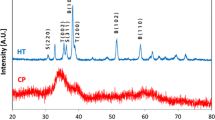Abstract
Poor reproducibility of the transparency of corundum ceramics produced by the alkoxy technology is related to the possibility of penetration of oxidized carbon from alkoxy groups into a solid solutions with Al2O3. Carbon neutralizes the effect of magnesium oxide additive and intensifies diffusion mass transfer, capture of pores by growing crystals, and polymorphous transformation into corundum. Introduction of carbon as soot or naphthalene into previously decarbonized Al2O3 powder in the course of dry milling, its subsequent heat treatment in air or in moist CO2 medium, and sintering of the samples in vacuum supported this assumption.
Similar content being viewed by others
References
W. H. Rhodes, “Agglomerate and particle size effects on sintering yttria stabilized zirconia,”Am. Ceram. Soc.,64(1), 19–22 (1981).
J. W. Halloran, “Agglomerates and agglomeration in ceramic processing,” in:Ultrastructure Processing of Ceramics, Glasses, and Composites, Wiley, New York (1984), pp. 404–417.
A. V. Belyakov, E. S. Lukin, and I. I. Nagayuk, “Ceramic technology based on powders prone to agglomeration,”Tr. MKhTI D. I. Mendeleeva, Issue 137, 88–95 (1985).
M. P. Harmer, “Science of sintering as related to ceramic powder processing,” in:Ceram. Powd. Sci. II: Proc. 1st Int. Conf. Ceram. Powd., Westerville, Ohio (1988), pp. 824–839.
A. V. Belyakov and A. N. Sukhozhak, “Problems of producing optically transmitting ceramics,”Steklo Keram., Nos. 1–2, 14–20 (1995).
B. E. Yoldas, “Effect of variations in polymerized oxides on sintering and crystalline transformations,”Am. Ceram. Soc.,65(8), 387–393 (1982).
G. D. Semchenko. “Low-temperature synthesis of SiC in heat treatment of hydrolyzed ethyl silicate gels,”Ogeupory Technich. Keram., No. 9, 14–19 (1996).
A. V. Belyakov, E. S. Lukin, A. S. Vlasov, and V. P. Tarasovskii, “Certain principles of selection of additives for producing transparent ceramics,” Tr. MKhTI D. I. Mendeleeva, Issue 118, 78–89 (1981).
A. V. Belyakov, “Chemistry of defects and nonequilibrium in production of poreless finely crystalline oxide ceramics,”Steklo Keram., No. 2, 6–7 (1999).
A. V. Belykov, “Stabilization of polymorphous phases in oxides. Polymorphous transformations,”Steklo Keram., No.2, 16–17 (1999).
A. V. Belyakov, “Stabilization of polymorphous phases in oxides. Polymorphous transformations,”Steklo Keram. No.3, 19–22 (1999).
G. S. Khodakov,Physics of Comminution [in Russian], Nauka, Moscow (1972).
V. A. Likholobov, “Catalytic synthesis of carbon materials and their use in catalysis,”Soros. Obraz. Zh., No. 5, 35–41 (1997).
V. S. Ivanova, A. S. Balankin, I. Zh. Bunin, et al.,Synergism and Fractals in Material Science [in Russian], Nauka, Moscow (1994).
Author information
Authors and Affiliations
Additional information
Translated from Steklo i Keramika, No. 9, pp. 18–22, September, 1999.
Rights and permissions
About this article
Cite this article
Belyakov, A.V., Pershikov, S.A. & Sukhozhak, A.N. Role of carbon in production of transparent corundum ceramics using the powder alkoxy technology. Glass Ceram 56, 284–288 (1999). https://doi.org/10.1007/BF02681377
Issue Date:
DOI: https://doi.org/10.1007/BF02681377




